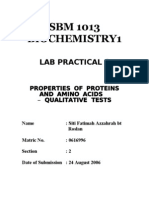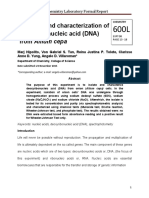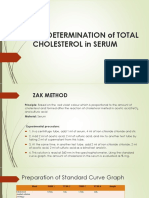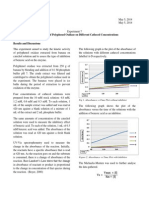Formal Report - Bradford
Formal Report - Bradford
Uploaded by
Aly ArcegaCopyright:
Available Formats
Formal Report - Bradford
Formal Report - Bradford
Uploaded by
Aly ArcegaCopyright
Available Formats
Share this document
Did you find this document useful?
Is this content inappropriate?
Copyright:
Available Formats
Formal Report - Bradford
Formal Report - Bradford
Uploaded by
Aly ArcegaCopyright:
Available Formats
PROTEIN ASSAY USING THE BRADFORD METHOD
AUTHORS
Anjeli Mae Aldueza, Fredrick Romulus Altea, Vanessa Amistad, Jose Ang Jr., Alyssa Eireen Arcega Group 1, 2D-Pharmacy, Faculty of Pharmacy, University of Santo Tomas
ABSTRACT
The Bradford assay is a rapid and accurate method for the estimation of protein concentration. The technique is simpler, faster than the Lowry method, and is subject to less interference. The objective of this part of the experiment is to quantitatively determine protein concentration in a given sample through Bradford assay. A series of test tubes were prepared with the first test tube containing the 1.5mL of distilled water and the last test tube containing 1.5mL of bovine serum albumin standard. The Bradford reagent of 1.5mL was added to each tube and mixed. It was stood for 5 minutes and the absorbance at 595nm was determined using the spectrophotometer. The albumin standard curve was the constructed by plotting A595 against concentration and the concentration of proteins was determined.
INTRODUCTION
The Bradford assay is a faster, involves fewer mixing steps, does not require heating, and gives a more stable colorimetric response. Its response is prone to influence from non-protein sources and becomes progressively more nonlinear at the high end of its useful protein concentration range. The response is also protein dependent, and varies with the composition of the protein. These limitations make protein standard solutions necessary. A spectrophotometer is employed to measure the amount of light that a sample absorbs. The instrument operates by passing a beam through a sample and measuring the intensity of light reaching a detector. The beam of light consists of a stream of photons. When, a photon encounters an analyte molecule, there is a chance the analyte will absorb the photon. This absorption reduces the number of photon in the beam of light, thereby reducing the intensity of the light beam.
gathered, a series of test tubes were prepared containing the following: Test tube no. 1 2 3 4 5 6 7 8 9 mL standard 0 0.10 0.15 0.20 0.25 0.30 0.35 0.40 0.45 mL H2O 1.50 1.40 1.35 1.30 1.25 1.20 1.15 1.10 1.05
MATERIALS AND METHODOLOGY
The materials used in the experiment include the Bradford assay, Bovine serum albumin (BSA) standard, test tubes, and a UV-Vis Spectrophotometer. After the materials were
Each test tube was added with 1.5mL of Bradford reagent and mixed well. The group let it stand for 5 minutes. The group then transferred an enough amount of each sample to a series of cuvettes and was placed inside the spectrophotometer. The first cuvette served as the blank while the rest of the cuvettes contained the samples. Each absorbance was read at 595nm. The albumin standard curve was then constructed by plotting A595 against concentration and the concentration of proteins was determined.
RESULTS AND DISCUSSIONS
The Bradford assay is commonly used to determin the total protein concentration of a sample. Using the linear regression method, the slope and y-intercept were determined. Table 1. Data of Bradford Assay Test tube 1 2 3 4 5 6 7 8 9 BSA(mL) 0 0.10 0.15 0.20 0.25 0.30 0.35 0.40 0.45 Water (mL) 1.50 1.40 1.35 1.30 1.25 1.20 1.15 1.10 1.05 Bradford reagent 1.5 1.5 1.5 1.5 1.5 1.5 1.5 1.5 1.5 Absorbance 0 0.868 1.012 1.171 1.188 1.620 1.227 1.240 0.911
REFERENCES
Crisostomo,A., Daya M., de Guia R., Farrow F., Gabona M., Liu I.,Pena G.,Pena L., Santiago L.,Santiago M., Sarile A., Torres P., Vargas A., Ysrael M., et al Laboratory Manual in General Biochemistry Quezon City: C & E Publishing Inc. Del Rosario A., et al Isolation and Characterization of Casein Bradford Protein Concentration Assay http://wolfson.huji.ac.il/purification/Proto cols/Bradfordassay
Graph 1. Standard BSA curve 2 1.5 1 0.5 0 0 5 10 Series1
You might also like
- Protein Assay Using The Bradford MethodDocument3 pagesProtein Assay Using The Bradford MethodTimmy CoNo ratings yet
- Protein Assay by The Bradford MethodDocument4 pagesProtein Assay by The Bradford MethodKat Buenaflor100% (1)
- Protein Assay Using Bradford MethodDocument3 pagesProtein Assay Using Bradford MethodRaymond Malubay100% (2)
- Protein Assay Using The Bradford Method: B. Procedure 1. Preparation of The SolutionDocument3 pagesProtein Assay Using The Bradford Method: B. Procedure 1. Preparation of The SolutionNaim Garcia MacasalongNo ratings yet
- Lab 3 Biuret Protein AssayDocument9 pagesLab 3 Biuret Protein Assayapi-384770852No ratings yet
- Lab Report Sds-Page WB - PT 1 (1-5)Document5 pagesLab Report Sds-Page WB - PT 1 (1-5)Ezad juferiNo ratings yet
- Staining TechniquesDocument19 pagesStaining TechniquesSwayamprakash PatelNo ratings yet
- LDH PurificationDocument24 pagesLDH PurificationFeynman Liang100% (1)
- Protein Assay Using The Bradford MethodDocument2 pagesProtein Assay Using The Bradford MethodAaron Lee100% (3)
- Colour Reaction of Amino AcidsDocument27 pagesColour Reaction of Amino AcidsNicola Faye BronNo ratings yet
- Identification of A Dipeptide UnknownDocument13 pagesIdentification of A Dipeptide UnknownVero Herrera CaroNo ratings yet
- Materials Characterisation ExercisesDocument4 pagesMaterials Characterisation Exercisesyaswanth1992No ratings yet
- USP Medicines Compendium - Etoricoxib - 2014-02-28 PDFDocument4 pagesUSP Medicines Compendium - Etoricoxib - 2014-02-28 PDFNeng Ayu Fitryanita67% (6)
- Determination of Copper Concentration Using UV-Vis SpectrophotometeryDocument7 pagesDetermination of Copper Concentration Using UV-Vis SpectrophotometeryNashDanielSilava100% (7)
- Bradford Formal ReportDocument4 pagesBradford Formal ReportAlyana100% (1)
- Quantitative Determination of Proteins Using Bradford MethodDocument2 pagesQuantitative Determination of Proteins Using Bradford Methodann_michelle7No ratings yet
- Formal Report Bio Chem 1Document1 pageFormal Report Bio Chem 1yel_reyes100% (1)
- Exp 3 - Bradford AssayDocument7 pagesExp 3 - Bradford AssayracelanjelicaNo ratings yet
- Bradford ReportDocument7 pagesBradford ReportNOXOLO NOMBULELO WENDY NGXONGONo ratings yet
- Bradford Protein Assay: Considerations For UseDocument4 pagesBradford Protein Assay: Considerations For UseRaja RajeshwariNo ratings yet
- Lab Report 5 FEER - Sem2Document14 pagesLab Report 5 FEER - Sem2Feer NordinNo ratings yet
- Sigma BCA Protein Assay ProtocolDocument6 pagesSigma BCA Protein Assay ProtocolssmaniNo ratings yet
- BCA Method of Protein EstimationDocument31 pagesBCA Method of Protein EstimationSwetha SundarNo ratings yet
- Biuret MethodDocument2 pagesBiuret MethodLarry LucianoNo ratings yet
- The Bradford Method For Protein QuantitationDocument7 pagesThe Bradford Method For Protein QuantitationChemiboyNo ratings yet
- Protein Lab ReportDocument7 pagesProtein Lab ReportFariha0% (1)
- DNA Quality-Spectrophotometry and ElectrophoresisDocument5 pagesDNA Quality-Spectrophotometry and Electrophoresislovina candra kirana100% (1)
- Bradford Protein AssayDocument3 pagesBradford Protein AssayFarhan AhmadNo ratings yet
- Sds PageDocument20 pagesSds Pageviswagithe s lNo ratings yet
- Biochem 313 Prac 5Document8 pagesBiochem 313 Prac 5Anonymous G8WVOfRqV100% (2)
- Lab ReportDocument7 pagesLab ReportAlliedschool DefencecampusNo ratings yet
- Determination of Constant of Ionization of A Weak Acid by Spectrophotometry 5Document6 pagesDetermination of Constant of Ionization of A Weak Acid by Spectrophotometry 5mmmsaNo ratings yet
- Lab Report Exp.6Document8 pagesLab Report Exp.6Qj B PdkhNo ratings yet
- Experiment 37B-2 Spectroscopic Analysis of Dyes - More Than Pretty ColorsDocument5 pagesExperiment 37B-2 Spectroscopic Analysis of Dyes - More Than Pretty ColorsHEEBA SATHYANo ratings yet
- Lowry AssayDocument7 pagesLowry AssayGrace AquinoNo ratings yet
- The Analysis Techniques of Amino Acid and Protein in Food and Agricultural ProductsDocument8 pagesThe Analysis Techniques of Amino Acid and Protein in Food and Agricultural ProductsMashuri UtamaNo ratings yet
- Amylase Assay 2Document9 pagesAmylase Assay 2Rahman ImudaNo ratings yet
- Total Protein Determination: Unit Intended Learning OutcomesDocument12 pagesTotal Protein Determination: Unit Intended Learning OutcomesMaria ClaraNo ratings yet
- Total ProteinsDocument16 pagesTotal ProteinsAhmad Ripani Musyaffa AhdanLabNo ratings yet
- Pka Determination Using SpectrometryDocument7 pagesPka Determination Using SpectrometryVanitha SelvarajanNo ratings yet
- Biochem 10A Lab QuestionsDocument6 pagesBiochem 10A Lab QuestionsPaul A IBattledaily Scavella100% (1)
- Optimization of Cellulase Enzyme From Vegetable Waste by Using Trichoderma Atroviride in Solid State FermentationDocument6 pagesOptimization of Cellulase Enzyme From Vegetable Waste by Using Trichoderma Atroviride in Solid State FermentationIOSRjournalNo ratings yet
- Analysis of Volhard's MethodDocument9 pagesAnalysis of Volhard's MethodKingsley WongNo ratings yet
- Venous Blood CollectionDocument4 pagesVenous Blood CollectionSheila Mae BuenavistaNo ratings yet
- ClustalwDocument5 pagesClustalwbioenvironNo ratings yet
- EXPT 2 LAB REPORT Extraction and Characterization of Proteins Group 2Document11 pagesEXPT 2 LAB REPORT Extraction and Characterization of Proteins Group 2Teach LesnitoNo ratings yet
- Enzyme KineticsDocument8 pagesEnzyme KineticsKaren Ivy Bacsain100% (1)
- Buffer TAE SpecificationsDocument2 pagesBuffer TAE SpecificationsMuhammad Pawpaw FauziNo ratings yet
- Report Reducing SugarDocument8 pagesReport Reducing SugarRedzuan Hussin83% (6)
- DNA Formal ReportDocument11 pagesDNA Formal ReportAngelo Dela Cruz Villaroman100% (3)
- 5.hafta Ingilizce Bik Pratik-3Document7 pages5.hafta Ingilizce Bik Pratik-3ManjuNo ratings yet
- Principle of Spectroscopy - Lab ReportDocument12 pagesPrinciple of Spectroscopy - Lab ReportRibka Kristania HadhiwaluyoNo ratings yet
- An Experiment in Enzyme Characterization-Banana PolyphenoloxidaseDocument3 pagesAn Experiment in Enzyme Characterization-Banana PolyphenoloxidaseKristiani SuhermanNo ratings yet
- Biuret AssayDocument6 pagesBiuret Assay门门No ratings yet
- Chromatography HPLCDocument16 pagesChromatography HPLCFilia YunizaNo ratings yet
- Enzyme KineticsDocument3 pagesEnzyme KineticsEricka GalangNo ratings yet
- Modified Lowry Protein AssayDocument6 pagesModified Lowry Protein AssaywakeyNo ratings yet
- High Pure Plasmid Isolation KitDocument17 pagesHigh Pure Plasmid Isolation KitiSaham MYNo ratings yet
- Assays For Determination of Protein ConcentrationDocument29 pagesAssays For Determination of Protein ConcentrationSam Joshva100% (1)
- Hotometry: Presenter: DR - Anurag YadavDocument28 pagesHotometry: Presenter: DR - Anurag Yadavanil markendeyaNo ratings yet
- Production of Pyruvate and AcetaldehdeDocument6 pagesProduction of Pyruvate and AcetaldehdeVictor Nyarugwe67% (3)
- Liquid Chromatography - Mass Spectrometry: An IntroductionFrom EverandLiquid Chromatography - Mass Spectrometry: An IntroductionNo ratings yet
- BradfordDocument3 pagesBradfordBien Emilio B NavarroNo ratings yet
- 2005 HPLC BrochureDocument2 pages2005 HPLC BrochureSyed RizviNo ratings yet
- CentrifugationDocument3 pagesCentrifugationAyushi VermaNo ratings yet
- Field Emission Scanning Electron Microscopy New PerspectivesDocument143 pagesField Emission Scanning Electron Microscopy New PerspectivesVeronica Correa100% (2)
- M.hamza Khan Me-215 - Muhammadhamza KhanDocument9 pagesM.hamza Khan Me-215 - Muhammadhamza KhanSyed Hassan.911No ratings yet
- SEMDocument52 pagesSEMSoumya MitraNo ratings yet
- AssiDocument3 pagesAssiScott BoothNo ratings yet
- 8 - geneMAP™ Thrombophilia Panel V2.3Document9 pages8 - geneMAP™ Thrombophilia Panel V2.3mirian flechaNo ratings yet
- Solving Inorganic Spectroscopic ProblemsDocument10 pagesSolving Inorganic Spectroscopic ProblemsDdd BbbNo ratings yet
- JNTU Anantapur M.Pharm Pharm Analysis SyllabusDocument18 pagesJNTU Anantapur M.Pharm Pharm Analysis SyllabusJareena BegumNo ratings yet
- Hrms Qtof Benc Htop: Sciex Sciex X500RDocument6 pagesHrms Qtof Benc Htop: Sciex Sciex X500RWulanNo ratings yet
- Calcium Analysis by Flame Atomic Absorption SpectrosDocument6 pagesCalcium Analysis by Flame Atomic Absorption SpectrosMark CarpesoNo ratings yet
- Analysis of Anisoles GCMSDocument3 pagesAnalysis of Anisoles GCMSIdrisAdesinaNo ratings yet
- Lecture 1 (Introduction To Histopathology)Document16 pagesLecture 1 (Introduction To Histopathology)Shayan AliNo ratings yet
- Aplikasi Metode X-Ray Fluorescence (XRF) Dan Fourier Transform Infra Red (FTIR) Untuk Analisis Unsur Kalium (K) Dan Kalsium (Ca) Dalam Sagu Asal Luwu TimurDocument2 pagesAplikasi Metode X-Ray Fluorescence (XRF) Dan Fourier Transform Infra Red (FTIR) Untuk Analisis Unsur Kalium (K) Dan Kalsium (Ca) Dalam Sagu Asal Luwu TimurKrappionNo ratings yet
- Group 3 Postlab LipidsDocument2 pagesGroup 3 Postlab LipidsSVPSNo ratings yet
- BM6703 IqDocument1 pageBM6703 Iq091 Santhosh MNo ratings yet
- Buffers ElectrophoresisDocument4 pagesBuffers ElectrophoresispersefoniNo ratings yet
- Wavelength Accuracy ReportDocument3 pagesWavelength Accuracy ReportRiad ManamanniNo ratings yet
- What Is NMRDocument7 pagesWhat Is NMRElumalaiNo ratings yet
- QC 351Document1 pageQC 351Rana TayyabNo ratings yet
- Ion-Exchange Separation and Complex Metric Titration Determination of Nickel and CobaltDocument10 pagesIon-Exchange Separation and Complex Metric Titration Determination of Nickel and CobaltMuhammad AlghitanyNo ratings yet
- Chapter 36 37Document31 pagesChapter 36 37HumairaNo ratings yet
- BlottingDocument36 pagesBlottingUsman Mahmood Usman MahmoodNo ratings yet
- Sem-Tem-XrdDocument32 pagesSem-Tem-Xrdaditya raaj100% (1)
- Vancomycin Hydrochloride USP 32Document4 pagesVancomycin Hydrochloride USP 32jorgeNo ratings yet
- Mass SpecDocument38 pagesMass SpecRashi VermaNo ratings yet
- Gel Filtration ExperimentDocument2 pagesGel Filtration Experimenthmahomed150% (2)

























































































